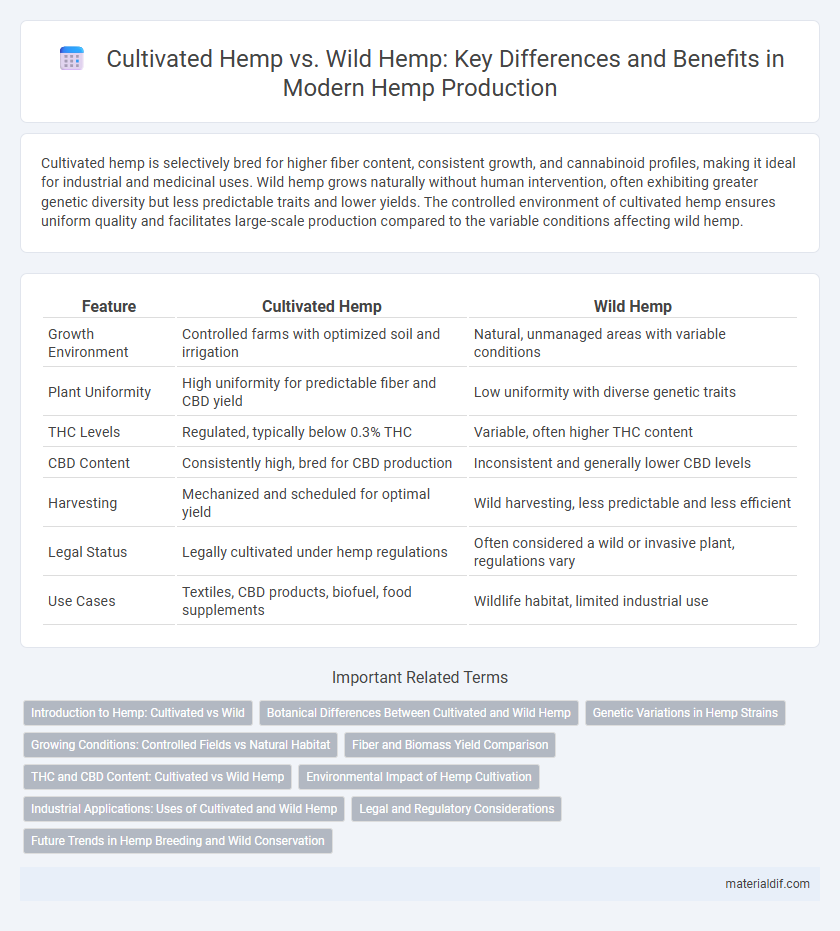Cultivated hemp is selectively bred for higher fiber content, consistent growth, and cannabinoid profiles, making it ideal for industrial and medicinal uses. Wild hemp grows naturally without human intervention, often exhibiting greater genetic diversity but less predictable traits and lower yields. The controlled environment of cultivated hemp ensures uniform quality and facilitates large-scale production compared to the variable conditions affecting wild hemp.
Table of Comparison
| Feature | Cultivated Hemp | Wild Hemp |
|---|---|---|
| Growth Environment | Controlled farms with optimized soil and irrigation | Natural, unmanaged areas with variable conditions |
| Plant Uniformity | High uniformity for predictable fiber and CBD yield | Low uniformity with diverse genetic traits |
| THC Levels | Regulated, typically below 0.3% THC | Variable, often higher THC content |
| CBD Content | Consistently high, bred for CBD production | Inconsistent and generally lower CBD levels |
| Harvesting | Mechanized and scheduled for optimal yield | Wild harvesting, less predictable and less efficient |
| Legal Status | Legally cultivated under hemp regulations | Often considered a wild or invasive plant, regulations vary |
| Use Cases | Textiles, CBD products, biofuel, food supplements | Wildlife habitat, limited industrial use |
Introduction to Hemp: Cultivated vs Wild
Cultivated hemp is selectively bred for specific traits such as high CBD content, low THC levels, and uniform growth, making it ideal for industrial, medicinal, and recreational uses. Wild hemp, or feral hemp, grows naturally without human intervention, often exhibiting greater genetic diversity but less predictable chemical profiles. Understanding the differences between cultivated and wild hemp is essential for optimizing production, ensuring legal compliance, and enhancing product quality in the hemp industry.
Botanical Differences Between Cultivated and Wild Hemp
Cultivated hemp (Cannabis sativa L.) exhibits controlled growth with uniform stem thickness, dense branching, and higher fiber content compared to wild hemp, which tends to have irregular growth patterns, taller and less branched stems, and lower fiber quality. Morphological differences include cultivated hemp's larger leaves and seeds optimized for industrial use, while wild hemp shows smaller leaves and a more fibrous texture adapted for survival in diverse environments. Genetic variation is more limited in cultivated hemp due to selective breeding, contrasting with the broad genetic diversity found in wild hemp populations.
Genetic Variations in Hemp Strains
Cultivated hemp strains exhibit selective breeding resulting in significant genetic variations optimized for fiber quality, cannabinoid profiles, and growth conditions, unlike wild hemp which maintains broader genetic diversity due to natural adaptation. These genetic differences impact traits such as THC content, CBD concentration, plant height, and resistance to pests, making cultivated hemp more predictable for industrial and medicinal use. Understanding the genetic variations between cultivated and wild hemp is essential for advancing breeding programs aimed at maximizing yield and chemical properties.
Growing Conditions: Controlled Fields vs Natural Habitat
Cultivated hemp thrives in controlled fields with optimized soil quality, irrigation, and nutrient management to maximize fiber and cannabinoid yield. Wild hemp grows in natural habitats where environmental factors such as unpredictable weather, soil variability, and competition with native plants affect its growth and chemical profile. Controlled cultivation ensures uniformity and higher productivity, while wild hemp exhibits genetic diversity and resilience to local conditions.
Fiber and Biomass Yield Comparison
Cultivated hemp varieties consistently produce higher fiber and biomass yields compared to wild hemp due to selective breeding and optimized growing conditions. Fiber yields from cultivated hemp can reach up to 8-10 tons per hectare, surpassing wild hemp's typical range of 3-5 tons per hectare. Biomass production in cultivated hemp also shows enhanced uniformity and density, making it more suitable for industrial applications such as textiles and bioenergy.
THC and CBD Content: Cultivated vs Wild Hemp
Cultivated hemp varieties are selectively bred to contain low THC levels, typically below 0.3%, while maximizing CBD content for industrial and medicinal use. Wild hemp exhibits variable THC and CBD concentrations, often higher THC levels that can exceed legal limits, making it unsuitable for commercial cultivation. The controlled cannabinoid profile in cultivated hemp ensures compliance with regulations and consistent product quality.
Environmental Impact of Hemp Cultivation
Cultivated hemp generally has a lower environmental impact compared to wild hemp due to controlled farming practices that optimize land use and minimize resource consumption. Industrial hemp farming reduces soil erosion and requires fewer pesticides and herbicides than many traditional crops, promoting sustainable agriculture. Wild hemp, while naturally resilient, can spread uncontrollably and disrupt local ecosystems, potentially leading to biodiversity loss.
Industrial Applications: Uses of Cultivated and Wild Hemp
Cultivated hemp is primarily used in industrial applications such as textiles, bio-composites, and biodegradable plastics due to its consistent fiber quality and higher cellulose content. Wild hemp, while less uniform, is often utilized in soil erosion control and phytoremediation efforts because of its hardiness and adaptability to diverse environments. The industrial preference for cultivated hemp stems from its standardized cannabinoid profiles and fiber properties, optimizing it for manufacturing and large-scale production.
Legal and Regulatory Considerations
Cultivated hemp is subject to strict legal regulations, including THC content limits typically set at 0.3% or lower, and requires licensing and regular testing under governmental frameworks such as the 2018 Farm Bill in the United States. Wild hemp, often referred to as feral hemp, grows without regulatory oversight, potentially leading to uncontrolled THC levels and cross-contamination risks with cultivated crops, complicating compliance for licensed growers. Regulatory agencies emphasize monitoring cultivated hemp to ensure product safety and market access, while wild hemp remains outside legal definitions, posing challenges for enforcement and agricultural management.
Future Trends in Hemp Breeding and Wild Conservation
Future trends in hemp breeding emphasize enhancing fiber quality, cannabinoid profiles, and environmental resilience through advanced genetic techniques such as CRISPR and marker-assisted selection. Cultivated hemp varieties are increasingly tailored for specific industrial applications, while preserving wild hemp populations remains critical for maintaining genetic diversity and ecosystem stability. Integrating in situ conservation strategies with breeding programs supports sustainable hemp production and long-term resource availability.
Cultivated hemp vs Wild hemp Infographic

 materialdif.com
materialdif.com